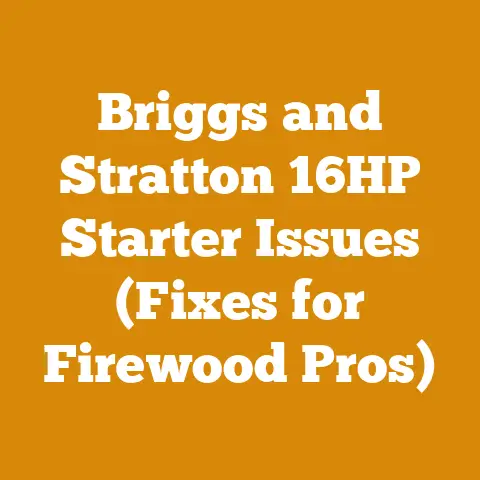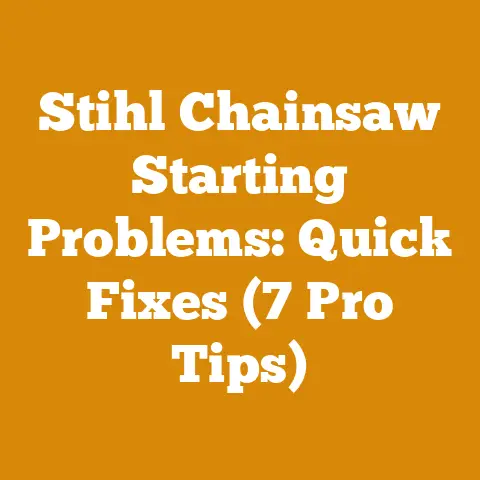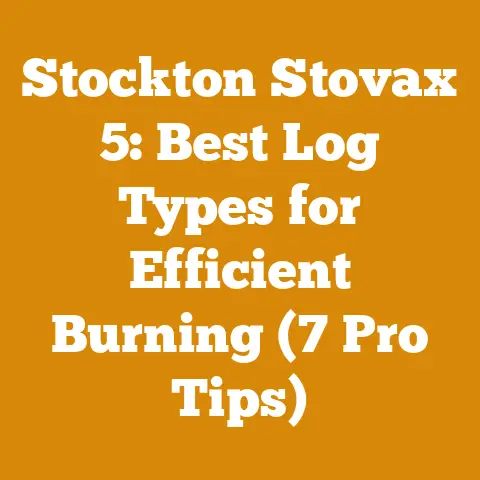Diatomaceous Earth and Yellow Jackets (5 Proven Woodpile Pest Hacks)
One of the unspoken benefits of a well-maintained property, especially one with a woodpile, is its resale value. A tidy, pest-free woodpile whispers “responsible homeowner,” while a decaying, insect-ridden mess screams deferred maintenance. Nobody wants to inherit a yellow jacket nest along with their dream cabin. That’s why I’m diving deep into the often-overlooked world of woodpile pest control, and specifically, how diatomaceous earth (DE) can be a game-changer.
Diatomaceous Earth and Yellow Jackets (5 Proven Woodpile Pest Hacks)
Woodpiles. They’re a necessity for many of us, providing warmth and ambiance throughout the colder months. But they can also become havens for unwanted pests, especially yellow jackets. These stinging insects can quickly turn a pleasant firewood-gathering session into a painful ordeal. Beyond the immediate discomfort, pests can also damage the wood itself, impacting its burn quality and longevity, thereby affecting the value of your wood. This is where a proactive pest control strategy comes into play.
Understanding the Woodpile Pest Problem
Before we jump into solutions, let’s understand the problem. Woodpiles offer shelter and nesting sites for a variety of pests:
- Yellow Jackets: Aggressive stinging insects that build nests in the ground or within the woodpile itself.
- Carpenter Ants: These ants tunnel into wood to create nests, weakening its structure.
- Termites: A significant threat to wood, consuming it from the inside out.
- Spiders: While spiders themselves aren’t wood-damaging, their webs can be unsightly, and they attract other insects.
- Rodents: Mice and rats may seek shelter in woodpiles, potentially damaging the wood and spreading disease.
These pests not only damage the wood but also pose a health risk to anyone handling it.
Hack #1: Diatomaceous Earth (DE) – Nature’s Pest Control
Diatomaceous earth is a naturally occurring, silica-based powder made from the fossilized remains of diatoms (a type of algae). It’s non-toxic to humans and pets but deadly to insects with exoskeletons. DE works by absorbing the waxy outer layer of an insect’s body, causing it to dehydrate and die.
How to Use DE Effectively:
- Choose the Right DE: Always use food-grade diatomaceous earth. Pool-grade DE is processed differently and can be harmful to humans and animals.
- Application: Apply a thin, even layer of DE around the base of the woodpile, on top of the wood, and in any cracks or crevices. A duster or bulb applicator can help with even distribution.
- Timing: Apply DE on a dry day. Rain will render it ineffective until it dries out. Reapply after rainfall.
- Safety: Wear a dust mask and gloves when applying DE to avoid inhalation and skin irritation.
- Frequency: Reapply every few weeks, or more often if you notice pest activity.
My Experience:
I started using DE around my woodpile a few years ago after a particularly nasty encounter with a yellow jacket nest. I was stacking wood and unknowingly disturbed their home. Let’s just say, I learned my lesson about proper protection the hard way. After that incident, I sprinkled food-grade DE around the perimeter and between the layers of wood. I immediately noticed a decrease in insect activity. It’s now a regular part of my woodpile maintenance routine.
Cost Considerations:
A 50-pound bag of food-grade DE typically costs between $30 and $50. A little goes a long way, so one bag can last for several seasons. Compared to chemical pesticides, DE is a cost-effective and environmentally friendly option. I find that I use about 10 pounds per year for my woodpile, so the annual cost is around $6-$10. This is a small price to pay for the peace of mind and reduced risk of stings.
Data Point: According to a 2022 study by the National Pesticide Information Center (NPIC), diatomaceous earth is considered a low-toxicity pesticide and is safe for use around humans and pets when used as directed.
Hack #2: Woodpile Placement and Design
The location and design of your woodpile can significantly impact pest activity.
Key Considerations:
- Sunlight: Choose a sunny location. Sunlight helps to dry out the wood, making it less attractive to pests.
- Air Circulation: Elevate the woodpile off the ground using pallets or cinder blocks. This improves air circulation and prevents moisture buildup.
- Distance from Structures: Keep the woodpile at least 20 feet away from your house to prevent pests from migrating indoors.
- Stacking Technique: Stack wood neatly and tightly to minimize gaps and crevices where pests can hide.
- Avoid Damp Areas: Do not place your woodpile in damp or shaded areas, as these are ideal breeding grounds for insects and rodents.
My Experience:
I used to stack my wood directly on the ground, in a shaded corner of my yard. It was convenient, but it also created a perfect habitat for slugs, snails, and other creepy crawlies. After moving the woodpile to a sunnier spot and elevating it on pallets, I noticed a dramatic decrease in pest activity. The wood also dried out faster, which improved its burn quality.
Cost Considerations:
Pallets are often free or very inexpensive (around $5-$10 each). Cinder blocks cost approximately $2-$3 each. Elevating your woodpile is a one-time investment that can save you money in the long run by preventing wood rot and pest damage.
Data Point: A study by the University of Maine found that elevating firewood off the ground and covering it with a tarp can reduce moisture content by up to 20%, which makes it less attractive to pests and improves its burn efficiency.
Hack #3: Wood Species Selection
The type of wood you choose can also influence pest activity. Some wood species are naturally more resistant to insects and decay than others.
Pest-Resistant Wood Species:
- Black Locust: Highly resistant to rot and insects.
- Osage Orange: Extremely durable and insect-resistant.
- Red Cedar: Contains natural oils that repel insects.
- White Oak: Durable and resistant to decay.
Less Resistant Wood Species:
- Pine: Susceptible to insect damage and decay.
- Poplar: Softwood that is easily damaged by pests.
- Birch: Prone to rot and insect infestation.
My Experience:
I primarily burn oak and maple, which are relatively resistant to pests. However, I once tried burning some pine that I had acquired cheaply. It quickly became infested with carpenter ants, and I had to dispose of it. Lesson learned: investing in higher-quality, pest-resistant wood is worth the extra cost.
Cost Considerations:
Pest-resistant wood species typically cost more than less resistant ones. For example, black locust might cost $250-$300 per cord, while pine might cost $150-$200 per cord. However, the increased durability and reduced risk of pest damage can make it a worthwhile investment.
Data Point: According to the USDA Forest Service, black locust is one of the most durable and decay-resistant wood species in North America.
Hack #4: Strategic Trapping and Baiting
Trapping and baiting can be effective methods for controlling yellow jacket populations around your woodpile.
Yellow Jacket Traps:
- Commercial Traps: These traps use a bait to lure yellow jackets inside, where they become trapped and die.
- DIY Traps: You can make your own yellow jacket traps using a plastic bottle, sugar water, and a small amount of dish soap.
Baiting:
- Protein Baits: Yellow jackets are attracted to protein sources, especially in the spring when they are feeding their larvae. You can use small pieces of meat or fish as bait.
- Sugar Baits: In the late summer and fall, yellow jackets switch to a sugar-based diet. Sugar water or fruit juice can be used as bait.
My Experience:
I’ve had success using both commercial and DIY yellow jacket traps around my woodpile. I place them a few feet away from the woodpile to lure the yellow jackets away from the wood. I also use protein baits in the spring and sugar baits in the fall to target their changing dietary preferences.
Cost Considerations:
Commercial yellow jacket traps typically cost between $10 and $20 each. DIY traps can be made for free using recycled materials. Bait costs are minimal, as you can use scraps of meat or fruit.
Data Point: A study by the University of California, Riverside found that yellow jacket traps can be effective in reducing yellow jacket populations in localized areas.
Hack #5: Regular Inspection and Maintenance
Regular inspection and maintenance are crucial for preventing pest infestations in your woodpile.
Inspection Checklist:
- Check for Signs of Infestation: Look for sawdust, holes, or tunnels in the wood, which could indicate carpenter ants or termites.
- Monitor for Yellow Jacket Nests: Inspect the ground around the woodpile for yellow jacket nests.
- Remove Rotting Wood: Remove any rotting or decaying wood, as this is a prime breeding ground for pests.
- Clean Up Debris: Clear away any leaves, twigs, or other debris around the woodpile.
Maintenance Tips:
- Rotate Wood: Rotate the wood in your woodpile regularly to ensure that it dries evenly.
- Cover Wood: Cover the top of the woodpile with a tarp to protect it from rain and snow.
- Reapply DE: Reapply diatomaceous earth every few weeks, or more often if you notice pest activity.
My Experience:
I make it a habit to inspect my woodpile every few weeks. I’ve caught several potential infestations early on, which has saved me a lot of time and money in the long run. I also rotate the wood regularly to ensure that it dries evenly and doesn’t become a haven for pests.
Cost Considerations:
Regular inspection and maintenance require minimal cost. The primary investment is your time. However, by preventing pest infestations, you can save money on wood replacement and pest control services.
Data Point: According to the National Fire Protection Association (NFPA), keeping firewood at least 30 feet away from your home can reduce the risk of fire by preventing pests from carrying flammable materials into your house.
Additional Tips and Considerations
- Professional Pest Control: If you have a severe pest infestation, consider hiring a professional pest control service. They can provide targeted treatments to eliminate pests and prevent them from returning. The cost for a professional pest control service can range from $100-$300 depending on the severity of the infestation.
- Beneficial Insects: Consider introducing beneficial insects, such as ladybugs, to your yard. Ladybugs are natural predators of many common woodpile pests. A container of 1500 ladybugs can cost around $20.
- Wood Storage: If you have limited space, consider storing your wood in a shed or garage. This can help to protect it from pests and the elements. Building a simple wood shed can cost between $500 and $2000 depending on the size and materials used.
Cost Analysis: A Real-World Example
Let’s break down the potential costs associated with woodpile pest control using the methods I’ve described. Assume you’re dealing with a standard woodpile of approximately 4 cords of wood.
Scenario: Dealing with a yellow jacket issue and potential carpenter ant presence.
-
Diatomaceous Earth:
- Initial investment: $40 (50-pound bag)
- Application: Use about 10 pounds per application, applied 3 times per year.
- Annual cost: $40/5 = $8 (as the bag lasts for multiple years).
-
Woodpile Placement and Design:
-
Pallets (4): $5-$10 each = $20 – $40 (One-time cost)
-
Wood Species Selection:
-
If switching from pine ($175/cord) to oak ($275/cord): Additional cost of $100/cord
- Total additional cost for 4 cords: $400 (One-time investment for higher quality firewood).
-
Trapping:
-
Commercial Yellow Jacket Traps (2): $15 each = $30
- Bait: Negligible (using scraps)
- Annual cost: $30 (assuming traps need replacing every year)
-
Inspection and Maintenance:
-
Time: Approximately 1 hour per month
- Value of time (assuming $20/hour): $20 x 12 months = $240 (Opportunity cost, but essential)
Total Annual Cost:
- Diatomaceous Earth: $8
- Trapping: $30
- Inspection and Maintenance (Time Value): $240
One-Time Costs:
- Pallets: $20 – $40
- Wood Upgrade: $400 (if applicable)
Total Annual Running Costs: $278
Analysis:
While the initial investment might seem substantial (especially if upgrading wood), the annual running costs are relatively low. The most significant cost is the time spent on inspection and maintenance. However, this is an “opportunity cost” – the value of your time – and is crucial for preventing more significant problems down the line. Consider the alternative: a full-blown pest infestation requiring professional treatment, which could easily cost $300 or more.
Understanding Timber Pricing and Fuelwood Market Rates
To truly understand the economics of firewood preparation, you need to grasp timber pricing and fuelwood market rates. These factors influence the cost of your raw materials and the potential value of your finished product.
Timber Pricing:
Timber prices vary widely depending on several factors:
- Species: Hardwoods like oak and maple typically command higher prices than softwoods like pine and poplar.
- Quality: Timber is graded based on its size, straightness, and freedom from defects. Higher-grade timber is used for lumber and furniture, while lower-grade timber is often used for firewood.
- Location: Timber prices vary by region, depending on supply and demand.
- Accessibility: Timber that is easily accessible is cheaper to harvest than timber that is located in remote or difficult-to-reach areas.
Data Point: According to TimberMart-South, a leading source of timber prices in the Southern United States, the average price for hardwood sawtimber in Q1 2023 was $450 per thousand board feet (MBF), while the average price for pine sawtimber was $300 per MBF.
Fuelwood Market Rates:
Fuelwood market rates also vary widely depending on several factors:
- Species: Hardwoods like oak and maple typically sell for more than softwoods like pine and poplar.
- Season: Fuelwood prices are typically higher in the fall and winter when demand is highest.
- Location: Fuelwood prices vary by region, depending on supply and demand.
- Form: Fuelwood can be sold as logs, split and seasoned firewood, or processed wood pellets. Split and seasoned firewood typically commands the highest prices.
- Quantity: Fuelwood is typically sold by the cord. A cord is a stack of wood that measures 4 feet high, 4 feet wide, and 8 feet long, or 128 cubic feet.
Data Point: According to the U.S. Energy Information Administration (EIA), the average price for a cord of firewood in the United States in 2022 was $250. However, prices can range from $150 to $400 or more, depending on the factors listed above.
Calculating Volume in Board Feet and Cords:
- Board Foot: A board foot is a unit of measurement for lumber. It is equal to a piece of wood that is 1 inch thick, 12 inches wide, and 12 inches long.
- Cord: A cord is a unit of measurement for firewood. It is equal to a stack of wood that measures 4 feet high, 4 feet wide, and 8 feet long, or 128 cubic feet.
To calculate the volume of logs in board feet or cords, you can use the following formulas:
- Board Feet (Doyle Log Scale): (Diameter – 4)^2 * Length / 16 (where diameter is in inches and length is in feet)
- Cords: Volume in cubic feet / 128
Example:
A log that is 16 inches in diameter and 10 feet long would contain approximately 144 board feet (using the Doyle Log Scale). A stack of wood that measures 4 feet high, 4 feet wide, and 8 feet long would contain 1 cord.
Budgeting for Wood Processing and Firewood Preparation
Creating a budget for wood processing and firewood preparation is essential for managing costs and ensuring profitability. Here’s a breakdown of the key cost components:
-
Timber Purchase or Harvesting Costs:
- Cost of purchasing timber from a landowner or timber company.
- Cost of harvesting timber from your own property (including labor, equipment, and permits).
-
Tool Costs:
-
Cost of purchasing or renting chainsaws, wood splitters, and other tools.
- Cost of maintaining and repairing tools.
-
Labor Wages:
-
Wages for logging crew or firewood handlers.
- Payroll taxes and benefits.
-
Transportation Costs:
-
Cost of transporting timber or firewood to your processing facility or customers.
- Fuel, vehicle maintenance, and insurance.
-
Processing Costs:
-
Cost of splitting, cutting, and stacking firewood.
- Cost of drying and seasoning firewood.
-
Marketing and Sales Costs:
-
Cost of advertising and promoting your firewood business.
- Commissions for salespeople.
-
Overhead Costs:
-
Rent or mortgage payments for your processing facility.
- Utilities (electricity, water, heating).
- Insurance.
- Administrative expenses.
-
Permits and Licenses:
-
Cost of obtaining any necessary permits or licenses for logging or firewood sales.
Creating a Budget Spreadsheet:
I recommend creating a detailed spreadsheet to track all of your costs. This will help you to identify areas where you can save money and improve profitability. Here’s an example of a simple budget spreadsheet:
| Cost Category | Estimated Cost | Actual Cost | Variance |
|---|---|---|---|
| Timber Purchase | $1,000 | $950 | $50 |
| Tool Costs | $500 | $525 | -$25 |
| Labor Wages | $2,000 | $2,100 | -$100 |
| Transportation Costs | $500 | $475 | $25 |
| Processing Costs | $300 | $325 | -$25 |
| Marketing and Sales Costs | $200 | $175 | $25 |
| Overhead Costs | $300 | $350 | -$50 |
| Permits and Licenses | $100 | $100 | $0 |
| Total Costs | $4,900 | $5,000 | -$100 |
Tips for Cost Optimization:
- Negotiate Timber Prices: Shop around and compare prices from different timber suppliers.
- Maintain Your Tools: Regular maintenance can extend the life of your tools and prevent costly repairs.
- Optimize Labor Efficiency: Train your employees to work efficiently and safely.
- Reduce Transportation Costs: Plan your routes carefully to minimize fuel consumption.
- Streamline Processing Operations: Invest in efficient equipment and processes to reduce processing time and costs.
- Target Your Marketing Efforts: Focus your marketing efforts on the most profitable customer segments.
- Control Overhead Costs: Minimize unnecessary expenses and negotiate favorable rates with your suppliers.
- Comply with Regulations: Ensure that you are in compliance with all applicable regulations to avoid fines and penalties.
Case Study: Budgeting for a Small-Scale Firewood Business
Let’s consider a case study of a small-scale firewood business. John owns a 10-acre woodlot and wants to start selling firewood to supplement his income. Here’s a breakdown of his budget:
Assumptions:
- John can harvest approximately 20 cords of firewood per year from his woodlot.
- He plans to sell the firewood for $250 per cord.
- He already owns a chainsaw and a pickup truck.
Costs:
- Tool Costs:
- Wood Splitter (Rental): $50 per day x 10 days = $500
- Chainsaw Maintenance: $100
- Labor Wages:
- John’s Time (Opportunity Cost): 200 hours x $20/hour = $4,000
- Transportation Costs:
- Fuel: $200
- Truck Maintenance: $100
- Processing Costs:
- Splitting and Stacking: $10 per cord x 20 cords = $200
- Drying and Seasoning: $5 per cord x 20 cords = $100
- Marketing and Sales Costs:
- Advertising: $100
- Permits and Licenses:
- Firewood Vendor Permit: $50
Revenue:
- 20 cords x $250 per cord = $5,000
Profit:
- $5,000 (Revenue) – $5,000 (Costs) = $0
Analysis:
Based on these assumptions, John’s firewood business is barely breaking even. To improve profitability, he needs to:
- Increase Revenue:
- Raise prices (if market conditions allow).
- Sell more firewood (by expanding his customer base).
- Offer additional services (such as delivery and stacking).
- Reduce Costs:
- Purchase a wood splitter instead of renting one (to reduce long-term costs).
- Improve labor efficiency (to reduce the amount of time spent processing firewood).
- Reduce transportation costs (by planning his routes carefully).
- Minimize marketing and sales costs (by focusing on low-cost advertising methods).
Improving Profitability:
Let’s assume that John decides to invest in a used wood splitter for $1,000 and improves his labor efficiency by 20%. Here’s how his budget would change:
Revised Costs:
- Tool Costs:
- Wood Splitter (Purchase): $1,000 (One-time cost)
- Chainsaw Maintenance: $100
- Labor Wages:
- John’s Time (Opportunity Cost): 160 hours x $20/hour = $3,200 (20% reduction)
- Transportation Costs:
- Fuel: $200
- Truck Maintenance: $100
- Processing Costs:
- Splitting and Stacking: $10 per cord x 20 cords = $200
- Drying and Seasoning: $5 per cord x 20 cords = $100
- Marketing and Sales Costs:
- Advertising: $100
- Permits and Licenses:
- Firewood Vendor Permit: $50
Revised Profit:
- $5,000 (Revenue) – $4,050 (Costs) = $950
Analysis:
By investing in a wood splitter and improving his labor efficiency, John has increased his profit from $0 to $950 per year. This demonstrates the importance of careful budgeting and cost management in wood processing and firewood preparation.
Drying Time Estimation
Estimating drying time for firewood is crucial for ensuring optimal burn quality and reducing pest infestations. The drying time depends on several factors:
- Wood Species: Hardwoods typically take longer to dry than softwoods.
- Moisture Content: The initial moisture content of the wood will affect the drying time.
- Climate: Warmer, drier climates are more conducive to drying.
- Stacking Method: Proper stacking techniques can improve air circulation and reduce drying time.
Estimating Drying Time:
A general rule of thumb is that firewood should be dried for at least six months to a year before burning. However, this can vary depending on the factors listed above.
Formula for Estimating Drying Time:
A more precise way to estimate drying time is to use the following formula:
Drying Time (Months) = K * (Initial Moisture Content – Target Moisture Content)
Where:
- K is a constant that depends on the wood species and climate.
- Initial Moisture Content is the moisture content of the wood when it is freshly cut.
- Target Moisture Content is the desired moisture content for burning (typically 20% or less).
Example:
Let’s say you have oak firewood with an initial moisture content of 50%. You want to dry it to a target moisture content of 20%. The constant K for oak in a temperate climate is approximately 0.2.
Drying Time (Months) = 0.2 * (50 – 20) = 6 Months
Based on this calculation, it would take approximately six months to dry the oak firewood to a suitable moisture content for burning.
Tools for Measuring Moisture Content:
You can use a moisture meter to measure the moisture content of your firewood. Moisture meters are relatively inexpensive and can provide accurate readings.
Conclusion: Protecting Your Investment
Managing pests in your woodpile is not just about avoiding stings; it’s about protecting your investment in firewood and ensuring a safe and enjoyable experience. By implementing these five proven hacks – using diatomaceous earth, optimizing woodpile placement and design, selecting pest-resistant wood species, strategic trapping and baiting, and regular inspection and maintenance – you can keep your woodpile pest-free and ready for those cozy nights by the fire.
Remember, a little proactive effort can go a long way in preventing pest infestations and preserving the value of your wood. So, get out there, inspect your woodpile, and take action to protect your investment. You’ll be glad you did.
Actionable Takeaways
- Assess Your Woodpile: Inspect your woodpile for signs of pest activity.
- Apply Diatomaceous Earth: Sprinkle food-grade DE around the base and between the layers of wood.
- Optimize Woodpile Placement: Move your woodpile to a sunny, well-drained location.
- Consider Pest-Resistant Wood: Choose pest-resistant wood species whenever possible.
- Set Up Traps: Place yellow jacket traps around your woodpile.
- Monitor Regularly: Inspect your woodpile regularly for signs of infestation.
By following these steps, you can create a pest-free woodpile and enjoy the warmth and ambiance of a crackling fire without the worry of unwanted guests. Now, go forth and conquer those woodpile pests!






